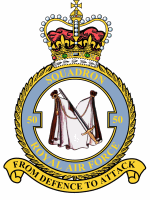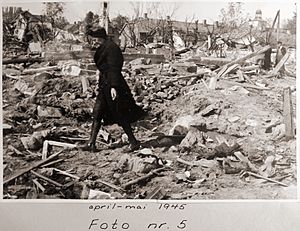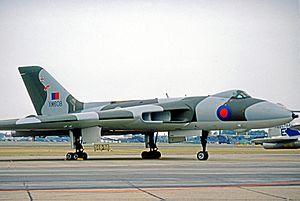No. 50 Squadron RAF facts for kids
Quick facts for kids No. 50 Squadron RAF |
|
|---|---|

No. 50 Squadron badge
|
|
| Active | 15 May 1916 – 13 June 1919 3 May 1937 – 31 January 1951 15 August 1952 – 1 October 1959 1 August 1961 – 31 March 1984 |
| Country | |
| Branch | |
| Motto(s) | Latin: Sic fidem servamus ("Thus we keep faith") The squadron badge also says "From Defence to Attack" |
| Battle honours | Home Defence, 1916-18*: Channel & North Sea, 1939-43*: Norway 1940: Baltic, Invasion Ports, 1940: 1940-43: France & Low Countries, 1940: Biscay Ports, 1940-44: German Ports, 1940-45*: Ruhr, 1940-45*: Berlin, 1940-44*: Fortress Europe, 1940-44*: Normandy, 1944*: France & Germany, 1944-45*: Walcheren: Rhine: Honours marked with an asterisk are those emblazoned on the Squadron Standard |
| Insignia | |
| Squadron badge heraldry | A sword in bend severing a mantle palewise. This unit formed at Dover and adopted a mantle being severed by a sword to show its connection with that town, the arms of which include St. Martin and the beggar with whom he divided his cloak. The mantle is also indicative of the protection given to this country by the Royal Air Force. |
| Squadron codes | QX Dec 1938 - Sep 1939 VN Sep 1939 - Jan 1951 |
No. 50 Squadron was a special flying group of the Royal Air Force (RAF). It was first created during the First World War to defend the home country from air attacks. Later, it became a bomber squadron during the Second World War and the Cold War. The squadron was finally closed down in 1984.
Contents
History of No. 50 Squadron
First World War: Defending the Home Front
No. 50 Squadron of the Royal Flying Corps (the RAF's earlier name) started in Dover on 15 May 1916. Its job was to protect Britain from enemy aircraft. The squadron used different types of planes, like the Royal Aircraft Factory B.E.2 and Royal Aircraft Factory B.E.12. These planes were based at various airfields around Kent.
The squadron flew its first battle mission in August 1916. Its planes helped to stop a German Zeppelin (a large airship) from attacking. On 7 July 1917, a plane from 50 Squadron, an Armstrong Whitworth F.K.8, shot down a German Gotha bomber near the North Foreland in Kent.
In February 1918, the squadron started using the faster Sopwith Camel fighter plane. They continued to defend Kent, and by October 1918, they were using their Camels as night fighters. During this time, the squadron began using a special "running dogs" symbol on their planes. This tradition lasted until 1984. The symbol came from their radio call sign, which was "Dingo." The squadron was closed on 13 June 1919. One of its last leaders was Major Arthur Harris, who later became a very important commander in the RAF during the Second World War.
Reformation and Second World War: Bomber Missions
No. 50 Squadron was started again at RAF Waddington on 3 May 1937. They first flew Hawker Hind biplanes, which are planes with two sets of wings. In December 1938, they began to switch to the Handley Page Hampden, a monoplane (a plane with one set of wings) medium bomber.
When the Second World War began, 50 Squadron was flying Hampdens. They were part of RAF Bomber Command, which was in charge of bombing enemy targets. Their first bombing raid was on 19 March 1940, targeting a seaplane base in Hörnum, Germany.
On 12 April 1940, 50 Squadron took part in a large British air raid. They tried to attack German warships near Kristiansand that were returning from the German invasion of Norway. Twelve Hampdens from 50 and 44 Squadron found a German warship. But they lost six planes to German fighters. After these heavy losses, the RAF stopped using Hampdens for daylight attacks.
50 Squadron continued to fly bombing missions at night throughout 1940 and 1941. In April 1942, they got new planes called Avro Manchesters. However, these planes had problems, especially with their engines. Even with these issues, 50 Squadron kept flying. They sent 17 Manchesters to "Operation Millennium" on 30/31 May 1942. This was a huge raid with 1,000 aircraft attacking Cologne. The squadron lost two planes that night. One of them was flown by Flying Officer Leslie Thomas Manser. He was later given the Victoria Cross (the highest award for bravery) because he kept flying his badly damaged plane to allow his crew to parachute to safety, sacrificing his own life.
The squadron soon switched to the four-engined Avro Lancaster, a very famous bomber. They used Lancasters for the rest of the war, bombing targets in Germany. Their last mission was on 25/26 April 1945, against an oil refinery in Vallø, Norway. During the war, 50 Squadron flew 7,135 missions and lost 176 aircraft. After the war, they replaced their Lancasters with Avro Lincolns. The squadron was closed down at Waddington on 31 January 1951.
Jet Operations: From Cold War to Tankers
No. 50 Squadron was started again at RAF Binbrook on 15 August 1952. This time, they flew English Electric Canberra jet bombers. They moved to RAF Upwood in January 1956 and were closed again on 1 October 1959.
The squadron reformed once more at RAF Waddington on 1 August 1962. They were equipped with the famous Avro Vulcan V bomber. These large jets were designed to carry nuclear weapons during the Cold War. In December 1966, they received newer Vulcan B.2s.
When the Falklands War started in April 1982, 50 Squadron was still flying Vulcans. Two Vulcan crews from the squadron were chosen for special missions called Operation Black Buck. These were very long-range bombing raids from Ascension Island to the Falkland Islands.
After the Falklands War, there was a need for more planes that could refuel other aircraft in the air. So, six Vulcans were changed into air-to-air refuelling tankers. The first converted plane flew on 18 June 1982 and started service on 23 June. No. 50 Squadron was chosen to operate these tanker planes. They were the very last unit to fly the Vulcan, and the squadron was finally closed down on 31 March 1984.
Aircraft Used by No. 50 Squadron
| Years | Aircraft Type | Specific Model |
|---|---|---|
| May 1916 – September 1917 | Royal Aircraft Factory B.E.2 | B.E.2c |
| May 1916 – May 1918 | Royal Aircraft Factory B.E.12 | |
| July 1918 – June 1919 | Sopwith Camel | |
| May 1937 – January 1939 | Hawker Hind | |
| December 1938 – April 1942 | Handley Page Hampden | |
| April 1942 – June 1942 | Avro Manchester | |
| May 1942 – October 1946 | Avro Lancaster | I & III |
| July 1946 – January 1951 | Avro Lincoln | B.2 |
| August 1952 – October 1959 | English Electric Canberra | B.2 |
| August 1961 – March 1984 | Avro Vulcan | B.1, B.2, K.2 |
Where No. 50 Squadron Was Based
- Swingate Down: 1916
- Harrietsham: 1916–1918
- Bekesbourne: 1918–1919
- RAF Waddington: 1937–1940, 1946–1951, 1961–1984
- RAF Lindholme: 1940–1941
- RAF Swinderby: 1941–1942
- RAF Skellingthorpe: 1942–1945
- RAF Sturgate: 1945–1946
- RAF Binbrook: 1952–1956
- RAF Upwood: 1956–1959



